Freshwater pearl mussel
The freshwater pearl mussel lives buried or partly buried in coarse sand and fine gravel in
clean, oligotrophic, fast flowing and unpolluted rivers and streams of low mountains.
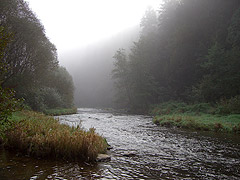
Typical habitat of the freshwater pearl mussel in the river Our (Picture Mireille Molitor)
This species whose pearls were used in former times as ornament has nearly become extinct
in the Ardennes.
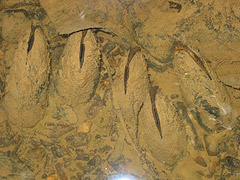
Margaritifera margaritifera in situ (Picture Alexandra Arendt)
Margaritifera margaritifera has a complex life-cycle with parasitic larvae (glochidia)
encysting on the gills of juvenile brown trout (Salmo trutta f. fario).
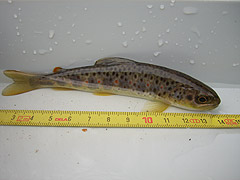
Juvenile brown trout (Picture Mireille
Molitor)
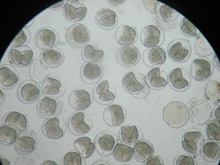
Larvae of the freshwater pearl mussel called
glochidia
The larvae remain on the fish for several months during the winter period before dropping off
in spring and settling into sediments of the river bed.
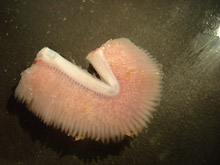
Gills of an infected brown trout (picture
LIFE Moule perlière Wallonie) |
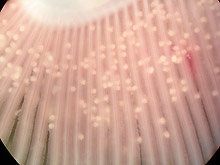
Encysted glochidia on host gills 1 |
Hidden in the sediment and protected from the water current and predators the young mussels
develop and are visible at the river bottom again after three to five years. Here they inhale
water through their exposed siphons to filter out minute organic particles on which they feed.
Freshwater pearl mussels are among the longest-living invertebrates known and individuals
can survive for up to 140 years. At the age of 10-15 years they become mature.
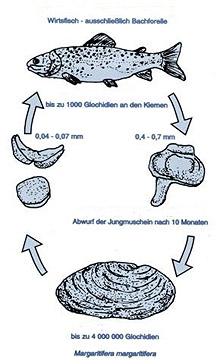
Life cycle 1
1 http://www.wwa-ho.bayern.de/projekte/ho/flussperlmuschel/fpm_lebensweise.htm
|